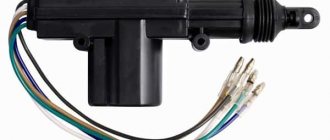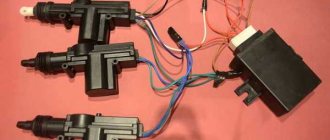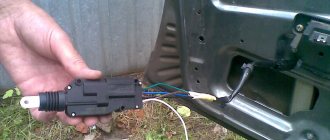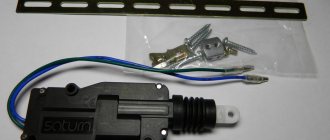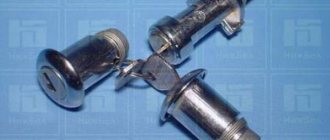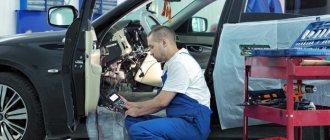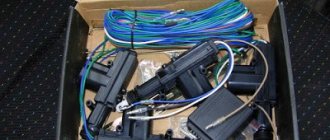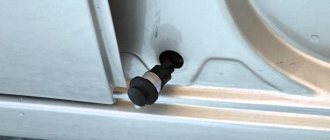This review discusses how to connect an alarm system to the central locking of the following cars: VAZ-21099, as well as 2110 and 2115. There are three standard connection schemes: for central locking controlled by negative polarity, positive and variable. But different cars have their own nuances. Sometimes it is necessary to add a fuse to the “+12 Volt” wire, sometimes, on the contrary, this is not required. VAZ locks, in turn, belong to the simplest type, the first. But the standard scheme published on the Internet is not suitable for them.
Central lock VAZ 2112
The VAZ-2112 central lock is considered a fairly safe device for the owner of this car. Keeping pace with progress, a person strives to be in time everywhere. This type of transport, such as a car, has long become not a luxury, but a means of transportation. According to statistics, every second person drives a car.
Does not work
The central locking motor may not work for a number of reasons:
There was a break in the winding near one of the poles.
If the supply voltage is applied for more than one second, the collector will heat up and after the end of movement, the hot collector leads to the melting of the plastic under its plates. Because the brushes are spring-loaded, they begin to connect, squeezing out the molten plastic, and when the brushes connect, the central locking power fuse burns out (after which the activator rod stops moving even manually). Often the reason for this is cheap alarms (for example, there is not enough time for the central locking system to close completely) and the cold season.
Overheating of the motor due to constant opening/closing in a short period of time (30-40 seconds).
Worn collector plates. In this case, the central locking does not always work, but every other time. The lubricant thickened, or the plastic was squeezed out from under the plates to the top due to the high pulse duration, and the collector overheated.
Where is
The block under the dashboard is approximately opposite to the right near the driver’s right knee, probably it can be called behind the display block. You'll have to unscrew the protection on the gas pedal and stick your hand high.
The fact is that all drives are connected in parallel. And if one does not work due to a block, then all the doors will not work. There remains a place for the standard twist in the threshold at the front near the driver's pillar, where the wires go into the door, the transition itself from the pillar to the door and the wires into the door.
Scheme
1 - mounting block; 2 - 8A fuse; 3 - control unit; 4 — gear motor for locking the lock of the right front door; 5 — gear motor for locking the right rear door; 6 — gear motor for locking the left rear door lock; 7 — gear motor for locking the lock of the right front door; A - to power supplies; B - diagram of conditional numbering of plugs in the control unit block; C - scheme for the conditional numbering of plugs in the blocks of geared motors for locking locks
Malfunctions
Inability to control the doors from the driver's door.
There is no power to the central locking control unit.
Burnt out or poor contact in the outboard fuse holder.
The fuse is connected to the wiring running behind the mounting block.
Source
Instrument panels VAZ VDO (LED)
You can install a more beautiful and convenient panel with LED indicators, the so-called VDO panel. Here VDO is the panel manufacturer.
| Connecting VDO on a Kalina car | ||
| 1 | Pink-white | To electric power steering |
| 2 | Blue and white | To the hazard warning indicator |
| 3 | Gray-blue | To emergency oil pressure sensor |
| 4 | Brown blue | To the parking brake switch |
| 5 | Yellow-blue | To the immobilizer control unit |
| 6 | Black | To the airbag control unit |
| 7 | Yellow | To the outside light switch |
| 8 | Blue | To the right turn signal switch |
| 9 | Blue with black | To left turn signal switch |
| 10 | White-blue | TO ECU |
| 11 | . | To brake pad wear sensor |
| 12 | . | To seat belt sensor |
| 13 | Black | To the traction control control unit |
| 14 | Red-blue | “RESET” key on the steering column switch |
| 15 | Pink-blue | To brake fluid level sensor |
| 16 | Black | To ABS |
| 17 | Green | To the high beam switch |
| 18 | White | To the instrument cluster light control |
| 19 | Brown | Panel weight |
| 20 | White-red | Terminal “30” |
| 21 | Orange | Terminal “15” |
| 22 | Yellow-red | To fuel flow sensor |
| 23 | Orange-white | MK key “forward” |
| 24 | White black | MK key “back” |
| 25 | Black and white | Outside temperature sensor (-) |
| 26 | Yellow-green | Outside temperature sensor (+) |
| 27 | Pink | Fuel level sensor |
| 28 | Grey | Speed sensor |
| 29 | Green-white | Coolant temperature sensor |
| 30 | Brown-red | Tachometer (low voltage) |
| 31 | . | Official. Panel diagnostics. |
| 32 | Brown-white | Terminal “L” of the generator relay regulator |
Why the central locking on the VAZ-2112 does not work: the main reasons
Central locking, or “CZ” as it is briefly called, is a necessary and essential thing for any car, allowing the owner to open and close any door in the car with just one movement of the hand. However, it happens that this system ceases to function completely, or its individual parts do not work properly.
There are reasons why one or another part of the central lock may fail, and we will discuss each in detail below.
The central locking does not work: signs of malfunction and causes of their occurrence
It happens that when the central lock located on the driver's door is closed, no action occurs on the other doors. However, as soon as you move it a little, the doors immediately closed. It is immediately clear that the problem here is the presence of malfunctions in the central locking and several reasons contribute to this.
Among all the possible causes of malfunctions, all the most basic ones can be identified.
No contact in the drive
With such a malfunction, the contacts inside the control drive do not close the necessary contacts in time. This happens for several reasons:
- The adjustment of the rod that connects the lock button and the drive is done incorrectly. This reason contributes to the incorrect position of the rod and lack of contact with the electric drive.
- The button touches part of the casing and does not allow it to lower to the required depth to ensure contact of the traction with the electric drive. Despite the fact that the driver's door closes, no signal comes to the other doors.
Check the condition of the metal rod.
When such problems occur in the operation of the central locking, first of all you need to make sure that the button is lowered to the very end. If for some reason this does not happen, first inspect the casing for burrs, and then inspect the rod for its even and accurate position.
Fuse blown
If manipulations with the central locking rod do not bring any results, and they do not react in any way to either opening or locking, then first of all you need to check its electrical circuit, and specifically the fuse. Because on the central lock it can fail not only if a short circuit occurs in the circuit, but also if the slightest overload occurs.
The central locking fuse is indicated by a marker.
Overload occurs most often from insufficient position of the rods, as well as lubrication in them during winter operation of the car.
The central locking wires are broken
Broken wires are not the main reason, but one of the reasons for the failure of the central locking system. The main reason for this is the break in the wires in those places where they bear the greatest load. Such a place is definitely the passage of the corrugation from the side of the pillar and the driver's door. And since it is the driver’s door that is most often opened in any car, it receives most of the load.
- It is quite easy to identify such a malfunction; you just need to release one of the ends of the corrugation through which the wires pass into the door and pull one of the five central locking wires. As a rule, they are connected into one bundle, or go next to each other.
- After carrying out such manipulations, a wire that is torn or broken will easily give in among the general heap.
- If you are absolutely sure that a particular circuit is faulty, replacing it will not be difficult by inserting the required wire and further insulating it with electrical tape.
- When the wires are broken or torn in other places, the fault can only be found by testing the circuit with a multimeter.
Block burned out
Another reason why the central lock may fail is a burnout of the central locking unit. And in order to diagnose it, you need to use the above-mentioned multimeter and determine the presence of voltage at the contacts of the block.
This is what the immobilizer and central locking unit look like behind the instrument panel.
Please note that during diagnostics it is necessary to operate the lock in the driver's door so that impulses are sent from it to the main unit.
The central locking activator is faulty
And the last reason why the central locking refuses to work is the failure of the activator on the central drive. It can fail both for mechanical reasons, due to wear of rubbing parts, and due to the influence of external factors of moisture and corrosion.
If the activator itself breaks down, it is necessary to replace the electric drive with a new one and replace it. Pay attention to the fact that the drive must have five wires of different colors.
VAZ instrument panel indicators - explanation
- coolant temperature gauge.
- tachometer;
- left turn signal indicator lamp;
- right turn signal indicator lamp;
- speedometer;
- fuel level indicator;
- fuel reserve warning lamp;
- side light indicator lamp;
- service brake system warning lamp;
- high beam indicator lamp;
- reset button;
- mileage indicator;
- warning lamp for turning on the hazard warning lights;
- "check engine" warning light;
- time and temperature indicator;
- battery charge indicator lamp or battery lamp;
- parking brake warning lamp;
- oil pressure warning lamp;
- reserve.
VAZ dashboard indicators play an important role in informing the user about malfunctions. They help prevent errors in the system, so it is important to know which indicator means what. How does the panel work? If any problem occurs, the sensor immediately sends information to the panel, and the driver will see an orange signal light up.
The earlier version of the instrument panel had some other symbols, such as emergency oil pressure, handbrake engaged, Chek Engine light, and several others that indicate minor operating errors, but which are no longer used.
The principle of operation of the central lock on the VAZ-2112
The central lock, which operates from the driver's door drive of the VAZ-2112, works as follows:
- The electric drive installed in the door is designed not only to control the lock, but also to issue a signal to the central locking unit. He, in turn, transmits commands to other doors to open and close the doors.
- In order for the driver's door drive to be so multifunctional, it has as many as five wires, unlike standard drives with two. Additional channels are intended for communication with the central locking control unit.
Drive for driver's and passenger's doors.
When the lock closes, the rod on the driver's door moves down, thereby closing certain contacts on the electric drive. From these actions, the central locking unit receives signals and transmits commands to the drives of all other door locks . Their discovery occurs in the same way.
Source
Design and principle of operation
The alarm control unit is the central element in the entire anti-theft system, interacting between all sensors and anti-theft subsystems. A control unit was built based on a central microprocessor that receives signals from sensors and control panels, processes information from them and makes decisions on further actions according to a pre-programmed algorithm of actions.
When installing an anti-theft system, security sensors are built into different parts of the car that detect vibrations, impacts and other external influences on the car. When information about an unusual situation is received from such sensors, an electronic signal is transmitted to the control unit. After processing this signal, the central processor turns on a sound and light alert about an attempted theft, transmits information to the control panel, and blocks those locks that were not closed at the time of operation.
When a coded signal is received from the remote control, the central processor can turn the car's security mode on or off, while locking or unlocking the car's doors and trunk.
The alarm control unit is equipped with a permanent storage device - a hard disk memory that can store information even in the absence of power. This is necessary so that in any situation all the standard settings and codes that are needed to disarm the car and arm it are saved.
Why the central locking on the VAZ-2112 does not work: reasons, repair
A week after the purchase, my Central Locking (CL) started acting up. At first, the alarm did not lock the car, I locked it with the key. And after a couple of days everything was completely covered.
We had to get into the car “the old fashioned way” and lift all the bolts in order to let anyone into the car. In general, it’s not very stressful, but maybe I’m wet myself, or maybe the 21st century outside is making itself felt. Having found some free time on Sunday, I drove off to a friend’s warm box and, according to the “Law of the Garage,” stuck there for the whole day.
Some of the photographs and diagrams were taken from the Internet.
To begin with, armed with a diagram, I looked at what awaits me and where the roots grow from. In general, everything is quite simple. 1. Mounting block.
2. 8 A fuse. 3. Control unit. 4. Right front door locking motor. 5. Motor reducer for locking the right rear door. 6. Left rear door locking motor. 7. Motor reducer for locking the left front door with a contact group. A - to power supplies; B - conventional numbering of plugs in the control unit block; C - conventional numbering of plugs in the blocks of geared motors for locking locks. The search for the fuse was not crowned with success for me, it was decided to check the wiring and not waste time. Finding the central locking control unit is also not so easy, it is located near the ECU at the feet of the driver and passenger behind the radio, if you are a gymnast, then removing it will not be a problem, and I refreshed my memory of the entire Russian vocabulary while I was removing it.
Using a 10mm wrench, I unscrewed the nut on the right side and left it on the stud on the left. It’s very inconvenient to remove. I took it off and smelled the relay. Seems normal. I took it apart, nothing burned was visible, the contacts were not oxidized. It's unlikely that it is. I called the store out of interest, the price tag of the relay is about 1400 wooden ones. The idea of checking another relay went away by itself))) I decided to dig in the opposite direction. I took off the driver's door trim, put the cartoon in my hands and go ahead and call the wiring according to the diagram. From the mounting block on chip “No. 1” there is a pink wire with a constant positive, there is 12V, we move on. The ground is ringing, which means the problem is not in the power supply. The wires between the activator and the central locking control unit are ringing. All is good. The activator current remained. I applied voltage, the activator worked every other time. Yeah) Maybe this is the villain.
A drill will help me) I clamped the activator in a vice, drilled out the rivets and disassembled it.
Basically, 2 gear wheels that open and close the door and a three-pin microswitch that sends a signal about opening or closing to the control unit, which gives a signal to other activators. I didn’t feel like running to the store and after calling about the relay I decided not to play with fate and restore old activator. We found a regular activator and took it apart. The motor costs the same. He will be the donor.
I quickly took it out, re-soldered it and put everything in place. Everything worked. I spent almost the whole day on such a small thing, but it’s still not clear why the tsz started working, because mechanically I blocked the contact. Maybe the wiring is a bit messed up, but fortunately everything works. The whole issue regarding the central lock remained resolved. I think someone will find this thread useful)
The VAZ-2112 central lock is considered a fairly safe device for the owner of this car. Keeping pace with progress, a person strives to be in time everywhere. This type of transport, such as a car, has long become not a luxury, but a means of transportation. According to statistics, every second person drives a car.
Contents Doesn't work Where is it Diagram Faults
Does not work
The central locking motor may not work for a number of reasons: The winding has broken near one of the poles.
If the supply voltage is applied for more than one second, the collector will heat up and after the end of movement, the hot collector leads to the melting of the plastic under its plates. Because the brushes are spring-loaded, they begin to connect, squeezing out the molten plastic, and when the brushes connect, the central locking power fuse burns out (after which the activator rod stops moving even manually). Often the reason for this is cheap alarms (for example, there is not enough time for the central locking system to close completely) and the cold season. Overheating of the motor due to constant opening/closing in a short period of time (30-40 seconds).
Worn collector plates. In this case, the central locking does not always work, but every other time. The lubricant thickened, or the plastic was squeezed out from under the plates to the top due to the high pulse duration, and the collector overheated.
Typical problems and their solutions
Electronic anti-theft systems of a car are subject to breakdowns and various types of malfunctions. In some cases, technical problems that arise can be resolved independently.
First of all, due to incorrect placement of additional shock and volume sensors, they may malfunction, and the alarm will go off without obvious reasons. An alarm that constantly goes off when the car owner is absent for a long time can completely discharge the battery and deprive the owner of the opportunity to start the engine. To eliminate this problem, it is recommended to check the correct placement and connection of the shock and volume sensors and, if necessary, reconnect them in accordance with the rules. Replace faulty sensors.
The alarm may not work correctly due to a large amount of interference interfering with the operation of the remote control. There are several solutions to solve this problem:
- Each time, bring the control panel as close as possible to the alarm unit or press the desired button several times.
- Reboot the alarm several times. To do this, just remove the power cable from the battery terminal for a few minutes, put it on and repeat the procedure 2-3 times.
- If possible, change the permanent parking location of the car, away from sources of interference.
If the anti-theft system does not respond to commands from the remote control, you should start troubleshooting the possible problem with the key fob. If commands from the key fob are well received up close, but do not work from a long distance, it means that the internal battery on the remote control has run out. You can replace it yourself.
Many remote controls have a battery charge indicator. If there is no such indicator, it is recommended to start fixing the problem by replacing the battery or charging the key fob.
If the remote control does not function with a fully charged battery, you need to check the alarm operation using a spare remote control. It is possible that the remote control itself is faulty. If the spare key fob controls the anti-theft system well, then it is recommended to replace the main one.
In cases where independent actions do not help to establish the operation of the anti-theft system, it is recommended to contact the service department.
This review discusses how to connect an alarm system to the central locking of the following cars: VAZ-21099, as well as 2110 and 2115. There are three standard connection schemes: for central locking controlled by negative polarity, positive and variable. But different cars have their own nuances. Sometimes it is necessary to add a fuse to the “+12 Volt” wire, sometimes, on the contrary, this is not required. VAZ locks, in turn, belong to the simplest type, the first. But the standard scheme published on the Internet is not suitable for them.
Where is
The block under the dashboard is approximately opposite to the right near the driver’s right knee, probably it can be called behind the display block. You'll have to unscrew the protection on the gas pedal and stick your hand high.
The fact is that all drives are connected in parallel. And if one does not work due to a block, then all the doors will not work. There remains a place for the standard twist in the threshold at the front near the driver's pillar, where the wires go into the door, the transition itself from the pillar to the door and the wires into the door.
Scheme
1 - mounting block; 2 - 8A fuse; 3 - control unit; 4 — gear motor for locking the lock of the right front door; 5 — gear motor for locking the right rear door; 6 — gear motor for locking the left rear door lock; 7 — gear motor for locking the lock of the right front door; A - to power supplies; B - diagram of conditional numbering of plugs in the control unit block; C - scheme for the conditional numbering of plugs in the blocks of geared motors for locking locks
Pinout of the dashboard of VAZ2110, 2111, 2112
- fuel reserve warning lamp;
- dashboard lighting lamps;
- right repeater indicator lamp;
- left repeater indicator lamp;
- VAZ plug block;
- coolant temperature sensor;
- indicator lamp for external lighting;
- carburetor air damper warning lamp;
- oil pressure warning lamp;
- handbrake indicator lamp;
- battery charge indicator lamp;
- VAZ tachometer;
- indicator light “CHECK ENGINE”;
- speedometer dashboard;
- brake fluid level warning lamp;
- hazard warning lamp;
- high beam indicator lamp;
- fuel level indicator.
| White block (X1) | Red block (X2) | ||
| 1 | Housing (weight) | 1 | To terminal “W” of the fuel level indicator sensor |
| 2 | Tachometer (low voltage input from ECU) | 2 | Fuse F19 + 12V power supply |
| 3 | Tachometer (high voltage input from coil) | 3 | Housing (weight) |
| 4 | Const +12V from battery (via 6th fuse) | 4 | Instrument lighting switch |
| 5 | Coolant temperature sensor. | 5 | Turn signal RIGHT |
| 6 | Fuse F1 (side light) | 6 | Turn signal LEFT |
| 7 | Throttle valve (“choke”) | 7 | Brake fluid level |
| 8 | Check Engine Light | 8 | To the trip computer |
| 9 | Fuse F19 + 12V power supply | 9 | Speed sensor |
| 10 | Fuse F19 + 12V power supply | 10 | Terminal “T” fuel gauge |
| 11 | Parking brake, terminal “VK” | 11 | Fuse F3 (high beam) |
| 12 | Generator output “D” | 12 | Hazard switch |
| 13 | Oil pressure sensor | 13 | To terminal “50” of the ignition switch |
Malfunctions
Good day everyone. In my last post I asked you for help and advice on repairing the central locking. Thank you all for your comments and responsiveness. Today in this post I will tell you how this problem was solved. So, initially the problem was that the car was armed, but the locks did not close. They also couldn’t be closed by manual pressing. It was decided to take everything apart and look. During disassembly, I found out that the driver’s door has a regular two-wire actuator, instead of the required 5-pin one. The remaining three contacts went to the lock itself; these were wires to the limit switch for the open/closed positions.
Full sizeThis is the actuator
Full size Here is the wiring to the central locking system, red and yellow are to the actuator, they alternately receive a signal depending on the position of the limit switch, the black wire is ground, and white and brown just transmit a signal about the position of the lock
Well, everything seems to be working at this stage.
Forcibly applied to the actuator. short-term
+12V, short-term, otherwise there will be an overload and it will either burn out or the brushes will close. He's twitching, which means he's alive. I went further to look for the reason.
I thought that the wires might have frayed in the place where they enter the door. He pulled out the bunch, and for good reason. Some wires had broken insulation - I fixed it with electrical tape.
Full size If you look closely, you can see exposed veins.
Let's go further, I read that there is a central locking control unit. We need to find him now. I opened up the floor covering to see where the beam went.
As a result, I found the end under the heater on the driver's side of the connector and on it a circuit rewound with electrical tape. Even then I felt that there was probably a problem with it, but out of ignorance, I continued my search further.
Full size Here is the old central control unit. As you can see, there are 6 wires coming here. Pink 12V, black ground, white, brown, yellow, red - I described them above. Here is the entire detailed wiring diagram, the colors matched.
Full size Central locking diagram for VAZ 2110, relevant for VAZ 2111 and VAZ 2112 In the end, I realized that all the signals reach this unit, there is power to it - but there is nothing at the output. That means it’s still dead. After shopping around, everywhere they offered me an 8-pin block, and only on the fourth day did luck smile on me and I bought the original 6-pin VAZ 2110 central locking block. It was immediately installed in its place, and I pressed it with bated breath signal - and hurray! closed, opened. Everything is as it should be!
Full sizeOld and new central locking blocks
Full size The connectors of the old and the new are identical. Well, since I’ve already taken apart a lot of everything, at the same time I tightened up all the masses. I also found two free two-pin chips in the same place in the driver’s feet under the stove. Maybe someone knows what they are for.
Full size Here they are in the distance, yellow and green, and purple and green, what kind of chips are they, tell me)
The well-known system, called central locking, as a rule, is not installed on all VAZ-2110 cars. Central locking is needed to simultaneously lock all car doors. This system is very convenient for the car owner. With one key you can control all doors. But, unfortunately, even such a system tends to break down. A large number of VAZ-2110 car owners face this. There are several reasons why the central locking may stop working or function incorrectly:
- Providing long or frequent pulses to control the opening or closing of doors.
- Central lock fuse is faulty.
- The plug connector has oxidized.
- Malfunction of the central locking control unit.
So, in order to understand the reason for the malfunction of the central locking, you first need to know what it consists of:
- electronic transistor control unit;
- actuators of the gearmotor (activator);
- limit switches;
- electrical wiring.
Selecting a security alarm for installation on a domestic car
The function of remotely closing and unlocking all car doors is mandatory for all types of modern anti-theft alarms. It is impossible to install an alarm without a central lock, so car owners are forced to install a central lock before purchasing a security system.
The trade offers motorists hundreds of models of anti-theft alarms in a wide price and functional range.
When choosing a car alarm for installation on domestic cars, the main selection criteria for car owners are:
- Affordable security system price. Experienced car enthusiasts do not buy the cheapest anti-theft alarms, doubting their durability and quality of work. Most Russian drivers prefer to buy car alarms from the middle price range.
- System functionality. Ordinary owners of VAZ models consider the car alarm to include a remote key fob, two or three sensors, a siren, and connection cables as a sufficient set of options.
- Possibility of self-installation. To implement this requirement at the purchase stage, you need to be interested in the complexity of the electronic control unit for the security system, detailed diagrams and instructions for connecting the anti-theft alarm. When installing it yourself, minimal disruption to the standard electrical wiring is desirable; it is not recommended to interfere with the operation of existing mechanisms.
Owners of VAZ-made models do not need to worry about the difficulties of flashing factory protections or bypassing standard immobilizers. However, experts do not recommend that novice car tuning enthusiasts begin work by independently installing security systems equipped with:
- remote engine start (remote engine start based on temperature, timer);
- coded dialogue communication system, GSM modules;
- numerous additional options (starting from a smartphone, turning on heaters, air conditioners).
If you want to install a full set of security options on a VAZ model, you will have to contact a specialized service, where they can install additional equipment.
The easiest way to install a simple car alarm with a minimum set of functions on your own.
On sale you will find dozens of simple anti-theft car alarms that are available for self-installation on VAZ models; all you have to do is choose the ones that are suitable for the price and set of functions.
Problems with central locking: reasons
Today, incorrect operation of the actuator is not uncommon. This problem is encountered quite often by owners of VAZ-2110 cars. But, much to our surprise, this problem can actually be dealt with without the intrusion of third parties. There is no need to look for a highly qualified specialist in the field of car electronics repair to fix the breakdown; it is easy to do it yourself if you wish. The first reason why the central locking system may fail is the fuse. Before you start disassembling the interior of the car, in order to understand the breakdown, you need to check the fuse. The second possible reason is that there is no contact in the drive. This is perhaps a common problem among central locking mechanisms. Another aspect of the malfunction can be broken wires. Also, the central locking system sometimes fails due to the control unit, which for one reason or another burns out. And finally, the reason why the central locking failed is a malfunction of the activator. The most important task of the owner of a VAZ-2110 car is to look for a breakdown of the central lock along the chain, starting with the fuse and ending with the control unit (CU).
Sensors in the central locking also often fail. Replacing them is quite easy. Every car owner can do this independently.
Since the car alarm is often closely connected with the lock, it is worth starting the check with this element. First you need to open and close the lock of the front left door using the key. If the central locking system works, it means that the alarm system has failed.
It is worth knowing that one of the main reasons for the lock mechanism to malfunction is a device called an activator. It is installed in the front doors of the car. Its main function is to send an electrical signal to all doors.
Who can you trust to install an anti-theft device?
There are the following options for installing an alarm on a VAZ 2110:
When installing this security system yourself, you must have certain knowledge and skills in the field of electronics and car design. The same requirements apply to friends, colleagues and acquaintances involved in these technological operations. The most successful option would be to shell out 2 – 2.5 thousand rubles and contact specialists in order to avoid failure or incorrect installation of fairly expensive equipment.
Some technical features of choosing a car alarm for a VAZ 2110
The anti-theft device must be selected with power outputs for direction indicators, repeaters and side light indicators. Such outputs are not suitable for low currents; there is a high probability of wiring burnout. If the system is structurally equipped with one power wire, then we select the side lights as the alarm indicator; if there are two wires, we connect the turn indicators and their repeaters on the wings. Such a security device must also have power outputs for the door locks. A pulse value of 0.8 s is sufficient for a VAZ 2110. A good car alarm for a VAZ 2110, a photo of which is posted on our website, should have different buttons for turning on and off the “anti-theft”; it is recommended to select a system with a dynamically changing radio pulse code, which negates the scanning recording the code of car opening by car thieves. We choose an ordinary, autonomous type of sound siren; for security alarm systems with reverse scanning, an isolated monotone siren with a power of 20 W is required.
LCD key fob for car alarm StarLine
Tools required to install a car alarm on a VAZ 2110
These tools include:
- Phillips head screwdriver
- Wrench or 10mm socket with wrench for ease of use
- A mechanic's knife (scalpel) and a lighter for stripping wiring
- Black impregnated fabric insulating tape with a fresh sticky surface
- Double-sided tape.
- Foam rubber, which is necessary to protect the control unit from mechanical damage and shock absorption during movement, is preferably dark in color
- Multimeter and skills to use it
- Selected car alarm for VAZ 2110, instructions for use are included
Selecting a location for installing a security device
During this procedure, fulfill the following conditions:
- Find a secret place to install the control unit in the car
- Do not install the control unit near heat sources and liquid filling equipment (heating and air conditioning systems)
- Do not install the control unit near active devices for receiving and transmitting radio waves (stations, auxiliary equipment, power wiring, etc.)
- The main requirement is that the wires are long enough to connect to the necessary devices.
- The control unit should be located as secretly as possible, in a hard-to-reach place
Car alarm control unit
We believe that it is better to attach the control unit to the instrument panel, having previously covered it with foam rubber cloth and leave open spaces for connectors.
The central locking of the VAZ-2110 does not work
If the situation is completely hopeless in repairing the central locking, then in this case you can try to purchase new mechanisms and install them yourself. In this way you can significantly save your own money. Central lock installation:
- disconnect the battery and remove the door trim;
- dismantle window regulators;
- remove old activators.
After carrying out the above steps, new activators should be installed. In order for new drives to work correctly, a lot of space is needed for free movement of the rod. Activators must be mounted on a flat surface so as not to impede the operation of the gear shafts. Before installing the drive in the door, you need to bend the rod correctly so that the bend angle is minimal. After installing the above element, you need to lay wires from each door to the place where the control unit will be mounted. The wires must be laid at the bottom of the door so that they do not collide with any moving mechanisms of the doors or body. The next step is installing the block. The control unit must be placed either in the car door or behind the instrument panel so that intruders do not have access to it. The place where the control unit (CU) will be installed must be dry. After installing the control unit, the next step is connecting the central locking wiring, which comes with the system.
Source
Pinout of the dashboard of VAZ2105, 2106, 2107
Old panel (with oil pressure gauge)
In addition to the presence of an oil pressure indicator, it is worth noting that this instrument panel does not have an air damper indicator lamp (choke), and the emergency oil pressure lamp is located next to the pressure indicator. Because of this, it contains lamps for low brake fluid levels and fog lamps.
White 6-terminal block X1:
- Gasoline level sensor
- Turn signal indicator lamp
- Battery charge sensor (voltmeter -)
- Gasoline level warning lamp
- Overall plus (+)
- Battery charge sensor (voltmeter +)
White 8 terminal block X2:
- Fog lamp warning lamp
- High beam warning lamp
- Dimensions indicator lamp
- Empty
- Battery charge indicator lamp
- Brake fluid level warning lamp
- Empty
- Parking brake warning lamp
Orange 6-terminal block X3:
- General minus (-)
- Tachometer VAZ
- Instrument lighting
- Oil pressure sensor
- Oil pressure warning lamp
- Coolant temperature sensor
New instrument panel (with econometer)
Here, everything is the other way around - there is no oil pressure indicator (instead there is an econometer), instead of a brake fluid level lamp there is a suction lamp (or an engine management system lamp on injectors), and instead of a fog lamp lamp there is an oil pressure lamp.
White 6-terminal block X1:
- Gasoline level sensor
- Turn signal indicator lamp
- Battery charge sensor (voltmeter -)
- Gasoline level warning lamp
- Overall plus (+)
- Battery charge sensor (voltmeter +)
White 8 terminal block X2:
- Dimensions indicator lamp
- High beam warning lamp
- Oil pressure warning lamp
- Empty, but there is a terminal in the wiring that goes to the brake fluid level sensor
- Battery charge indicator lamp
- Indicator lamp for the air damper (choke) or engine control unit for injectors
- Empty
- Parking brake warning lamp (handbrake)
Orange 6-terminal block X3:
- General minus (-)
- Tachometer (if this contact is empty, then the tachometer is on pin #4)
- Instrument lighting
- Empty, and if not empty - to the tachometer
- Empty
- Coolant temperature sensor
